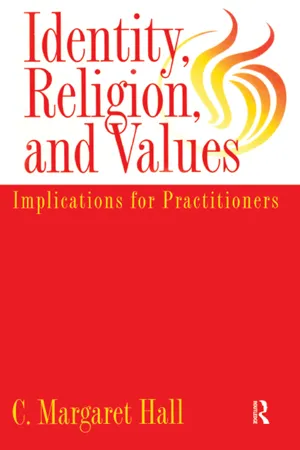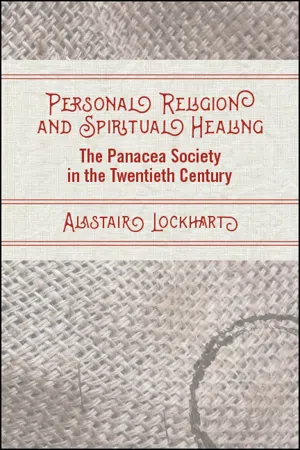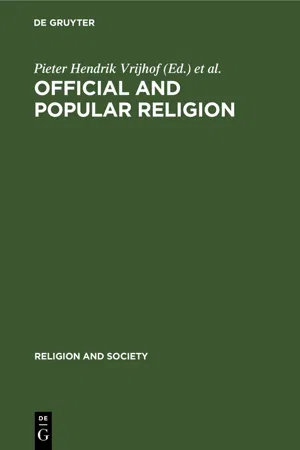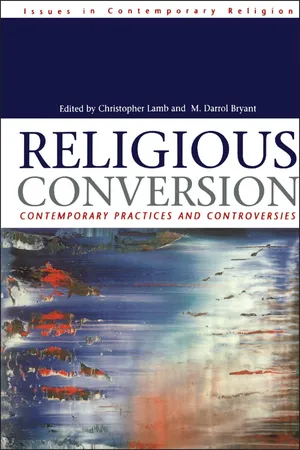History
Religious Change
Religious change refers to the transformation of religious beliefs, practices, and institutions over time. It can be caused by a variety of factors, including social, political, and economic changes, as well as the influence of new ideas and religious movements. Religious change has played a significant role in shaping the course of human history.
Written by Perlego with AI-assistance
Related key terms
1 of 5
4 Key excerpts on "Religious Change"
- eBook - ePub
Identity Religion And Values
Implications for Practitioners
- C. Margaret Hall(Author)
- 2019(Publication Date)
- Taylor & Francis(Publisher)
Chapter 10 Social Change and ReligionHistorically, religions have served as both conservative forces and catalysts for change. In their capacities as repositories of meanings, religions can motivate large numbers of individuals—even whole populations—either to sustain traditions or to reformulate goals and ideals and do things differently (Lenski, 1951). Moreover, it is only through using a broad historical perspective that people can sufficiently understand the depth and scope of religious influences, and the strength of their impact on the quantity and quality of social life and social change (Ashbrook, 1993).Religious differences have caused violently destructive battles in many times and places (Eisler, 1987). This destruction is linked to religions because abstractions and rigidities in belief systems frequently generate dogmas that provoke disputes and conflicts (Finke & Stark, 1992). It is this kind of bigotry that accentuates religious differences so much that they become irretrievably contradictory and incompatible, with the result that national and international disagreements may escalate into overt conflict and warfare (Eisler, 1987; Lerner, 1986).Religions can be thought of as consisting of those beliefs that are both individually and socially experienced as sacred (Wuthnow, 1992). Although it is crucial to forge identities through basing actions on uniqueness, and through expressing specific values of meaningful groups, there is also a point at which it is important deliberately to identify with the whole human race. For example, although it may be meaningful to identify with all women, it is also morally significant to conduct behavior according to membership in humankind. Although many people realize that there is no escape from the human condition, and that biology knows few cultural or status differences, these universal characteristics and realities have to be actively acknowledged for people to identify with the whole human race. Even where nation states no longer completely define citizens’ everyday circumstances, as they did in the 18th century, awareness of their membership in the world community must be cultivated—an awareness that in fact is facilitated by modern scientific and technological advances (Appleyard, 1993). Group moral agencies such as religions or even political parties may be prime movers of change, but individuals and groups must recognize and accept their responsibilities for the implementation and consequences of the particular changes they initiate. - eBook - ePub
Personal Religion and Spiritual Healing
The Panacea Society in the Twentieth Century
- Alastair Lockhart(Author)
- 2019(Publication Date)
- SUNY Press(Publisher)
CHAPTER THREEUnderstanding Religion
The classic historiographical and sociological claim about the nature of Religious Change amid the modernization of societies has been understood as a claim about the decline of religion—the secularization thesis. In line with recent ideas about this thesis, which query the validity of the inherent teleology of the notion and seek instead to understand Religious Change as being made up of lived social and spiritual processes, this chapter analyzes and assesses a range of formulations of the theory. It suggests that while classic theorists may have been presented as predicting and describing the ultimate demise of religion, an attentive reading of many of these authors’ texts identifies how religion is explicitly presented as persisting in some way. After establishing the core point, that theses of secularization have not inherently excluded the continuation of religion into the future, the chapter proposes a framework for employing a revised secularization thesis as a method in the study of contemporary religiosity, and especially those forms that are generally understood to be characteristically recent developments: flexible and individual forms in dynamic and noninstitutional contexts. In the framework of the Society’s extraordinary global reach, its accessibility to people of all faiths and across all backgrounds, and its chronological spread across the twentieth century, the letters of the Panacea Society’s healing users are a valuable resource for a study using the methodology proposed.THEORIES OF Religious Change
There is a longstanding tradition of sociological analysis and conventional wisdom that has perceived a more or less inevitable process of religious decline in modern cultures, especially in those where Christianity has been the dominant mainstream religion. The historian Hugh McLeod, for example, lists a canon of sociologists who “shared a commitment to the ‘secularization thesis’ … that the dwindling social significance of religion is an inevitable consequence of the process of social development in modern societies.”1 Anthony Carroll has observed that “secularization has been, until recently, an uncontested motif of accounts of modernity” and that “for much of the twentieth century, the theory of secularization was a cultural a priori that informed all thought about the modern world and its emergence from the medieval past.”2 Classic accounts of the dynamics implicated in secularization theory, such as Peter Berger’s Social Reality of Religion, describe “the process by which sectors of society and culture are removed from the domination of religious institutions and symbols” with a concomitant process for individual consciousnesses so that “the modern West has produced an increasing number of individuals who look upon the world and their own lives without the benefit of religious interpretations.”3 A number of contemporary scholars have found evidence to confirm the paradigm. Perhaps the strongest protagonist for secularization as a fundamental theoretical tool for the understanding of Religious Change presently is Steve Bruce. Bruce notes an ebb and flow of religious influence in Europe over a long period but detects decline overall and finds no historical case where there has been a “reversal of decline.”4 - eBook - PDF
Official and Popular Religion
Analysis of a Theme for Religious Studies
- Pieter Hendrik Vrijhof, Jacques Waardenburg, Pieter Hendrik Vrijhof, Jacques Waardenburg(Authors)
- 2019(Publication Date)
- De Gruyter Mouton(Publisher)
W. E. A. VAN BEEK 16 Traditional Religion as a Locus of Change 1. The Problem The last decennia have shown an increased conscious-ness of the historic character of religious systems. Any religion we encounter has to be studied as the momentary manifestation of a historical process. This historicity is quite clear for those religions that have their roots long in written history and are of-ten based on writings from ages past, it is much less evident for religions not based on writing. These preliterate (1) religions long tended to be viewed as stable homeostatic systems in which change and dis-ruption came from outside: tribal people are supposed to have held their customs and beliefs for many gener-ations, and only under the impact of white coloni-sation, Christian missions and the sledgehammer of western material culture did a substantial transfor-mation take place. The reasons put forward why pre-literate religions would know hardly any change, are generally the following: - in religion as elsewhere tribal societies have little labour specialisation; their homogeneity bars change from within and acceptance of new i terns. - preliterate religion is all-pervasive: all aspects of social life are impregnated with religion, and any Religious Change would seriously upset the whole fabric of this closely integrated whole. E.g.: 'In primitive religions theoretical notions and concepts are less important than in higher ci-vilisations, Hardly any activity has no cultic significance. Traditional Religion 515 Eating, sleeping, fighting and cohabition, they all can be considered as activities through which man communicates with the Divine' (Wach, 1958, p. 143-144). - the deadweight of tradition acts as a buffer a-gainst change. Traditional orientations protect against innovations, and blot out any chance novelty by 'harking back to the ways of the an-cestors '. - eBook - PDF
Religious Conversion
Contemporary Practices and Controversies
- Christopher Lamb, M. Darroll Bryant(Authors)
- 1999(Publication Date)
- Continuum(Publisher)
Part I Conversion: theoretical perspectives This page intentionally left blank 1. Converting: stages of Religious Change1 Introduction Religious Change characterizes an enduring quality of the human predicament. Whether it entails converting from one religious tradition to another, changing from one group to another within a tradition, or the intensifying of religious beliefs and practices, instances of conversion can be found in many cultures, historical periods, economic conditions and social categories. Although 'conversion', as a theological word, is used most often within the Christian tradition, it has come to refer to the general notion of Religious Change. Because definitions of conversion abound, the phenomenon of conversion continues to be an elusive concept. This chapter proposes that 'converting' is the most appropriate term to signify that Religious Change is an ongoing complex process involving many different dimensions, and provides a heuristic stage model which can serve as a framework in which the nature of the converting processes can be seen more adequately. 2 Given our assumption that converting is a process, a stage model is useful in portraying phases of a process that takes place over time. We realize that speaking of 'stages' involves the use of metaphorical language. Human life is rarely so simple and orderly. We believe that a stage model is valuable as a map of the features of change over time. We propose seven stages in this model. Context is the overall environment in which change takes place. Contextual factors either facilitate or constrain change. The crisis stage is generally a rupture in the taken-for-granted world that triggers the quest stage in which persons actively seek new ways of confronting their predicament. Encounter is the contact between questing persons and the advocate 23 Lewis R. Rambo and Charles E. Farhadian LEWIS R. RAMBO AND CHARLES E. FARHADIAN of a new alternative.
Index pages curate the most relevant extracts from our library of academic textbooks. They’ve been created using an in-house natural language model (NLM), each adding context and meaning to key research topics.



